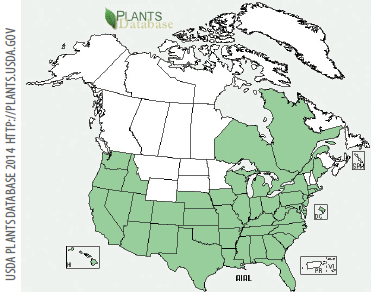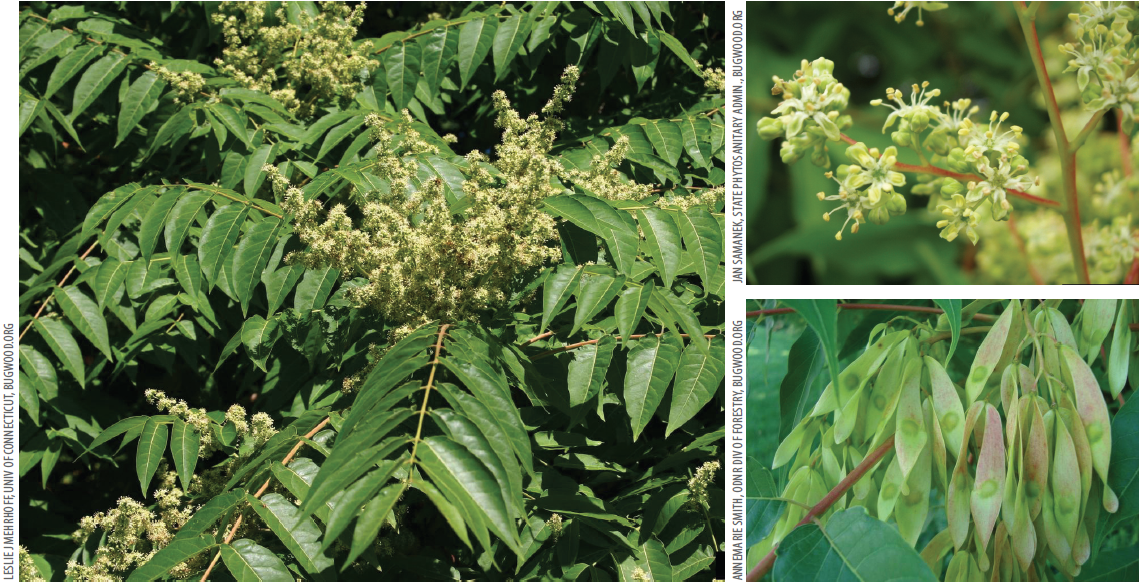


Tree-of-heaven (Ailanthus altissima), also called stinking sumac or Chinese sumac is naturalized throughout much of the United States. It was first introduced into the eastern United States in the late 1700s from China. Ease of establishment, rapid growth and absence of insect or disease problems resulted in tree of heaven being extensively planted in U.S. towns and cities during the 1800s. Today this invasive tree threatens to overwhelm natural areas, agricultural fields and roadsides in many states. Tree-of-heaven is adapted to a wide variety of ecological sites ranging from urban areas, saline soils, surface-mined lands and natural areas. High seed production (325,000 seeds per female tree) and viability, and vegetative sprouting from the roots increase this plant’s invasiveness.
Description
Tree-of-heaven can reach 80 feet in height, with smooth pale gray bark and light chestnut brown twigs. Leaves are compound, one to four feet in length, alternate, and composed of 10 to 41 smaller leaflets. Each leaflet has one or more glandular teeth along the lower margin. The leaf margins are otherwise entire or lacking teeth. Male and female flowers usually occur on separate trees (dioecious); however, both bisexual and uni-sexual flowers have been reported on individual tree-of-heaven. Flowers occur in large terminal clusters and are small and pale yellow to greenish. Flat, twisted, winged fruits each containing a single central seed are produced on trees in late summer to early fall and may remain on the trees for long periods of time. All parts of the tree, especially the leaves and flowers, have a distinct burned-nut odor.

Management Options
Manual and Mechanical
Early detection and removal of tree-of-heaven seedlings before the tap root develops is the most effective control strategy. Pulling or digging must remove the entire root system, including all roots and root fragments, to prevent regrowth. Suckers from a pre-existing lateral root are nearly impossible to remove by manual methods.
Cutting or mulching without a follow-up herbicide treatment is not effective since tree-of-heaven produces sprouts and root suckers from a cut stump. Continued removal of above ground growth may exhaust root reserves under heavily shaded canopy.
Biological Control
Limited work on biological control insects for tree-of-heaven has been conducted overseas but no agents are available for release in the United States (R. Hanson, personal communication). Field and laboratory research has also been conducted on the indigenous, soil-borne fungus Verticillium albo-atrum and Verticillium nonalfalfae. The fungus has been observed to cause wilting and death of tree-of-heaven in forest habitats. Two additional fungi, Verticillium dahliae and Fusarium oxysporum, have been isolated from dead and dying tree-of-heaven in New York and in southern and western Virginia. No fungal agents are approved for biological control at this time.
Herbicide
Several herbicides and application techniques can provide tree-of-heaven control. Remember, the root system must be killed in order to control the plant and prevent sprouting from the stump or suckering from the root. The following methods were found to be effective in field research trials and operational treatments.
Foliar Application
Broadcast foliar applications are typically the most cost-effective treatment in dense tree-of-heaven infestations. Foliar herbicide application with Vastlan®, Garlon 4 Ultra, Capstone®, or glyphosate (Accord®XRT and others) will provide good control where tree-of-heaven size and distribution allow for effective foliar coverage. Capstone, Vastlan, and Garlon 4 Ultra are selective for broadleaf and woody plants and will not kill desirable grasses contacted by the spray. Glyphosate is non-selective and will kill or cause injury to herbaceous or woody plants contacted by over-spray during the foliar canopy application. Apply Capstone and Vastlan at a 2% solution and Garlon® 4 Ultra at a 1.5% solution from June through early September. Glyphosate can be applied at a 2% solution.
Cut Stump
Research trials conducted at University of California at Davis looked at effectiveness of glyphosate, Garlon 4 Ultra and imazapyr applied as cut stump or basal bark applications on tree-of-heaven control compared to mechanical cutting only (DiTomaso and Kyser 2007). Results showed that manual cutting alone did not provide tree-of-heaven control. Garlon 4 Ultra (20% v/v in oil) applied as a cut-stump application resulted in more than 90% reduction in both vigor ratings and re-sprouting of single stems and stem-clusters and provided similar control to imazapyr, but significantly better control than glyphosate (Table 1). Although control was excellent in research trials, some invasive plant managers have reported significant re-sprouting following cut stump herbicide treatment (Law and Evans, personal communication).

Basal Bark Application
This treatment method is generally used for trees that are less than six inches in diameter and is preferred by many operational field managers. In the California study, basal bark applications with Garlon 4 Ultra and imazapyr provided excellent tree-of-heaven control (Table 2). Researchers concluded that although both Garlon 4 Ultra and imazapyr provided similar control results, imazapyr is a broad-spectrum herbicide and applications often result in a “dead vegetation zone” around the treated trunk. Garlon® 4 Ultra is a selective herbicide and less phytotoxic to non-target desirable vegetation. Field studies on other tree species have also shown that Garlon 4 Ultra is a better choice for basal bark application when desirable vegetation surrounds the target tree.

Based on research results and field observations, the optimum application timing for basal bark and cut stump treatments is a late summer or fall application timing when carbohydrates are translocating to below-ground tissues.
Stem Injection [Hack and Squirt] Application
The stem injection technique can provide effective control of individual tree-of-heaven stems or stem-clusters. Recommended herbicides include undiluted Vastlan, Garlon 4 Ultra, imazapyr or glyphosate injected into cuts. Stem cuts should be spaced so that a minimum of 1 to 2 inches of uncut living tissue remains between eachcut. Although DiTomaso and Kyser (2007) found that imazapyr provided the most effective control as a stem injection treatment, observations from field managers also report good control with Vastlan and Garlon® 4 Ultra in stem injection treatments. A slightly different application method, drill and squirt, has been reported to kill above-ground portion of the tree, but tree-of-heaven roots continued to resprout with this technique (Tony Summers, personal communication). Overall, reports from invasive plant managers indicate basal bark treatments provide more effective control than stem injection methods.
Key Points
- Tree size and site conditions dictate the management method selected for tree-of-heaven control.
- An advantage of using a stem injection, basal bark, or cut stump application methods, rather than foliar treatment, is the low risk of off-site movement through spray drift.
- A cut stump technique would be most appropriate with very large trees or stem-clusters having well-developed bark. The bark of these plants would be difficult to penetrate with the stem injection method and would not likely absorb herbicide using a basal bark treatment.
- Late summer or fall herbicide application timing for basal bark and cut stump treatments is more effective at reducing sprouting compared to applications made in late spring and summer.
- Early fall herbicide applications followed by periodic evaluations the following spring with follow-up retreatment of sprouts was reported to provide the best long-term control of an infestation.
- Manual removal can be effective on small, newly established populations but all root fragments must be removed to be effective.
- Mechanical cutting or burning without herbicide application will not control tree-of-heaven and may increase density.
Road Survey of the Invasive Tree-of-Heaven in Virginia
The invasive nonnative tree-of-heaven invades newly disturbed areas and forms large monospecific stands. The mean density of tree-of-heaven throughout 5,175 km of roads surveyed in Virginia was 39 km−1 with mean infestation of 58% of 1.6-km road segments.
References
Boyda E, J Rebbeck, D Apsley. 2013. Biology and control of Ailanthus. MIPN Invasive Plant Symposium presentation. Online. http://www.mipn.org/2013Symposium.html.
DiTomaso JM, GB Kyser. 2007. Control of Ailanthus altissima Using Stem Herbicide Application Techniques. Arboriculture and Urban Forestry. 3(1):1- 9.
Evans, Chris. Southern Illinois. Personal Communication.
Hansen, Richard. USDA APHIS. Personal Communication.
Kelly M. 2001. Results of basal bark applications of Garlon 4 on Ailanthus altissima (tree-of-heaven). In Proc., California Exotic Pest Plant Council Sym. 6:105–107.
Law, James. Inland Empire Resource Conservation District. Personal communication.
Panke B and M Renz. 2013. Management of Invasive Plants in Wisconsin: Tree-of-heaven (Ailanthus altissima). Univ. of Wisconsin. Coop. Ext. Bulletin. No. A3924-33.
Rebbeck J, J Jolliff, D Davis, E O’Neal. 2013. Ailanthus Wilt, a Potential Biocontrol Agent in Ohio Forests. MIPN Invasive Plant Symposium. Online. http://www.mipn.org/2013Symposium.html.
Summers, Tony. University of Wisconsin-Madison. Personal Communication. USDA, NRCS. 2019. The PLANTS Database (http://plants.usda.gov, 26 May 2019). National Plant Data Team, Greensboro, NC 27401-4901 USA.
Published 2014; Reviewed and Updated November 2019.
Celestine Duncan contributed to this article.
™ ® Trademarks of Corteva Agriscience and its affiliated companies. State restrictions on the sale and use of Garlon 4 Ultra herbicide apply. Consult the label before purchase or use for full details. Vastlan herbicide is not registered for sale or use in all states. Contact your state pesticide regulatory agency to determine if a product is available for sale or use in your state. Always read and follow label directions. © 2021 Corteva.
Techline Invasive Plant News
Sharing innovative research, success stories and tips with invasive plant managers.